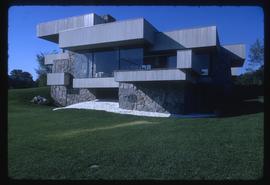Identity elements
Reference code
US NBP 2012.MARIS-F06-S6.1
Name and location of repository
Level of description
Subseries
Title
Osofsky House, Shelter Island, New York
Date(s)
- Sep. 1971 (Creation)
Extent
98 35 mm slides; 4 large-format black-and-white negatives; 4 8 x 10 black-and-white prints; 2 large-format color negatives; varied photographic materials
Name of creator
Biographical history
William Austin Maris was born at his maternal grandmother’s house in Woodside, Queens, on October 28, 1924. Shortly after his birth, his mother returned with him to the family home in Steubenville Ohio. Maris’ father, Constantine Maris, had opened a photo studio in the 1920s, where his artistically-inclined mother, a photographer, printed in the studio’s darkroom, hand painted photographs and also designed and made costumes and backgrounds. Indeed, the entire Maris family was creative – his sister Minerva Maris Wagner would later become a professional photographer with the Miami Herald; another sister, Helen Maris, was also an artist . The young Bill Maris took up photography early on, recalling that by the age of seven he and his sister Minerva had begun setting up a large format camera on the street (no doubt supplied by his father’s studio) in order to photograph passersby. Maris graduated from high school during World War II and enlisted in the army as a photographer. Following the war, he relocated to the Lower East Side in New York, where he soon joined a professional and social circle of artists and photographers. He was loosely connected with the Photo League at this time, and made use of their accessible darkrooms. This period in New York would become a formative one for Maris politically, culturally and artistically, and from the late 1940s on, his work was concentrated in and around the city. In the early 1950s, Maris met his future business partner, former architecture student-turned master photographer Ezra Stoller, noted for elevating architectural photography to an art form. During their partnership, Maris photographed such landmark structures as the TWA Terminal at John F. Kennedy Airport (then Idlewild Airport), the Ford Foundation Building, and the Seagram Building. Maris and Stoller continued working together until the mid-1960s when they dissolved their business partnership (though the two remained on friendly terms). During the 1960s and early 1970s, Maris' architectural clients included I.M. Pei, Groupius's firm The Architects’ Collaborative (TAC), Richard Meier, Charles Gwathmey, Robert A.M. Stern, Julian and Barbara Neski, and Norman Jaffe, among others. He also completed numerous magazine assignments, primarily on the East Coast, for publications such as House & Garden, House Beautiful, and Traditional Home. His commercial clients included IBM and Avon Corporation. He also photographed the works of architects and designers Norman Foster, Michael Graves, Eero Saarinen and Frank Gehry, in addition to interior designers such as Jack Lenore Larsen and Timo Sarpaneva. Maris’ work has been acquired by institutions such as the Yale University Art Gallery and the San Francisco Museum of Modern Art’s architecture and design collection. Maris died in New York, New York, on December 16, 1986.
Name of creator
Biographical history
Most known for single-home designs but also designed urban residential complexes, office towers and industrial buildings.


